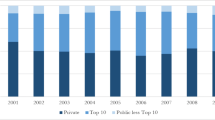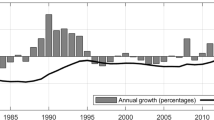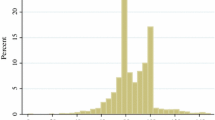Abstract
This article uses a unique demonstration program to examine the interaction of CRA-related lending with subprime and FHA lending activity. Specifically, the empirical analysis identifies the extent to which the origination of a CRA mortgage substitutes for FHA and subprime originations during the period 1998–2006. The results suggest that in the years prior to the expansion of the subprime market (1998–2001), the origination of CRA loans carried a small substitution effect with respect to FHA originations, with little to no impact on subprime originations. Conversely, during the years of the subprime industry’s growth (2002–2006), CRA originations substituted at a much higher rate for high-cost originations. These findings are suggestive about the dynamic role of community reinvestment lending within the changing context of the broader mortgage market. To the extent that CRA originations carry lower foreclosure risk than many subprime products, they also carry implications for the extent of neighborhood externalities in the wake of the subprime foreclosure crisis.


Similar content being viewed by others
Notes
Avery et al. (2000) also offer a detailed examination of CRA special lending programs at the institutional level.
Interpretation of these estimates is also limited to the local average treatment effect implicit in the regression discontinuity design.
This article focuses on mortgage choice in a market with risk-based pricing. It therefore seeks to review those analyses that include subprime mortgage options, and is brief in addressing the FHA-conventional choice. Readers seeking a more complete discussion should refer to LaCour-Little (2007) and to Pennington-Cross and Nichols (2000).
The latter ‘specially targeted mortgage program’ reflects a partnership between a national bank and the GSEs.
The analysis also offers new evidence that a need to close quickly and/or a desire for reduced documentation requirements related to self-employment predict the use of subprime products.
Gabriel and Rosenthal (2009a) similarly find that GSE purchasing crowds out private sector loan purchases, finding modest crowd out from 1994–2003 and nearly complete crowd out between 2004–2006. Gabriel and Rosenthal (2009b) and Bhutta (2009b) find much smaller crowd out of GSE activity for subprime lending using regression discontinuity designs, but examine only the underserved areas goal and not the full set of GSE affordable lending goals.
This study helps to explain the apparent paradox between evidence that the affordable lending goals increased purchasing activities (Bunce 2002; Temkin et.al. 2000), but had limited impacts on housing outcomes (An et.al. 2007; Bostic and Gabriel 2006). The analysis shows that the impact on FHA lending acts to moderate the direct effect of GSE purchases on housing outcomes.
The CAP program does not require private mortgage insurance on purchased loans, instead applying a 50–100 basis point credit enhancement. As a result, CAP mortgages carry interest rates that hover just above the prime rate, but can be considered comparable to prime loans with respect to total cost to the borrower.
The authors report results for a simplified set of CAP purchasing criteria, excluding the third category.
The primary exclusion to reporting to HMDA is for small institutions. In 2006, depositories whose assets totaled less than $35 million and non-depositories whose assets totaled less than $10 million were exempted.
Rural observations are excluded from analysis in response to concerns about the reliability of HMDA data in these areas.
Ideally, this model might also be estimated using loan-level data. However, the sheer size of such a dataset is prohibitive. For the period from 1998 to 2006, such an analysis would exceed 30 million observations and is not possible with available computing resources.
In all analyses, standard errors are clustered at the tract level to adjust for serial correlation across years.
As CAP loans were originated, borrowers were contacted and recruited into a longitudinal survey. An early lesson of this process was that borrowers were not familiar with the CAP program.
The additional HMDA characteristics are commonly used to construct additional covariates in other analyses. However, because CAP loans are not identifiable in HMDA data, the inclusion of such variables biases the estimate with respect to CAP. For instance, a CAP loan appears both as a prime loan and as a lower-income loan. Any included income counts would therefore identify CAP loans in the same way as the CAP variable of interest, diluting its effect. For this reason, such variables are not included.
Additional analyses also explored the inclusion of a MSA-level measure of housing price appreciation. The annual appreciation rate is calculated from the MSA index reported by OFHEO. This measure is omitted from the analyses due to concerns about endogeneity with respect to the number of loan originations. The empirical results are similar when this appreciation measure is omitted/included.
Because tract definitions are generally redrawn in response to population growth, the elimination of tracts that do not have consistent boundaries is likely to disproportionately remove fast-growing areas. While this reflects non-random elimination of sample observations, the impact is likely minimized by the nature of the analysis, which focuses on variation across time within tracts.
See Freddie Mac’s Primary Mortgage Market Survey [http://www.freddiemac.com/dlink/html/PMMS/display/PMMSOutputYr.jsp?year=2008].
CAP loans generally carry a credit enhancement of roughly 75 basis points. The interest rates reported for the prime market by PMMS exclude borrowers’ mortgage insurance payments.
The measure of CAP lending can also be defined as whether at least one CAP origination is observed. The results when this form of the CAP variable is used are qualitatively similar, although the magnitude of coefficients is larger (as should be expected). The number of CAP originations is used in the results presented, as it allows for direct interpretation of the coefficients.
The breakdown of tracts by number of years with a cap loan is as follows: 1 year (57%); 2 years (21%); 3 years (9%); 4 years (6%); 5 years (3%); 6 years (2%); 7 or more years (2%). As a robustness check, all analyses are repeated when the sample excludes observations with 3 or more years with an observed CAP loan.
As an additional robustness check, the analyses are also repeated when tracts with 2 or more observed CAP loans in a single year are eliminated from the sample.
The positive association between the presence of a CAP loan and the number of FHA originations in the second panel of Table 4 is inconsistent with a priori expectations about the impact of CAP lending. However, given that the estimate is small and carries a non-significant t-statistic, this result does not raise major concerns that any unobserved effect drives the substantive results presented.
As the subprime industry grew, the array of loan options offered by subprime and prime lenders began to overlap, with prime lenders competing for higher-cost loans.
This rate spread is operationalized in HMDA by calculating an implied annual percentage rate (APR) for the mortgage and comparing it to the outstanding rate on Treasury securities of comparable maturity.
References
An, X., & Bostic, R. W. (2008). GSE Activity, FHA Feedback, and Implications for the Efficacy of the Affordable Housing Goals. Journal of Real Estate Finance and Economics, 36(2), 207–231.
An, X., & Bostic, R. W. (2009). Policy Incentives and the Extension of Mortgage Credit: Increasing Market Discipline for Subprime Lending. Journal of Policy Analysis and Management, 28(3), 340–365.
An, Xudong, Raphael W. Bostic, Yongheng Deng, & Stuart A. Gabriel. (2007). “GSE Loan Purchases, the FHA, and Housing Outcomes in Targeted, Low-Income Neighborhoods.” Brookings-Wharton Papers on Urban Affairs, 205–256.
Apgar, W. C., & Duda, M. (2003). The Twenty-Fifth Anniversary of the Community Reinvestment Act: Past Accomplishments and Future Regulatory Challenges. FRBNY Economic Policy Review, 9(2), 169–191.
Avery, Robert B., Raphael W. Bostic, & Glenn B. Canner. (2000). “CRA Special Lending Programs.” Federal Reserve Bulletin 86(November), 711–731.
Avery, Robert B., Kenneth P. Brevoort, & Glenn B. Canner. (2006). “Higher-Priced Home Lending and the 2005 HMDA Data.” Federal Reserve Bulletin 92(September), A123–A166.
Barr, M. S. (2005). Credit Where it Counts: The Community Reinvestment Act and its Critics. New York University Law Review, 80(2), 513–652.
Berry, Christopher R. & Sarah L. Lee. (2007). “The Community Reinvestment Act: A Regression Discontinuity Analysis.” Harris School Working Paper Series #07.04.
Bhutta, Neil. (2009a). “The Community Reinvestment Act and Mortgage Lending to Lower Income Borrowers and Neighborhoods.” Federal Reserve Board Working Paper, August
Bhutta, Neil. (2009b). “GSE Activity and Mortgage Supply in Lower-Income and Minority Neighborhoods: The Effect of the Affordable Housing Goals.” Federal Reserve Board Working Paper.
Bostic, R. W., & Gabriel, S. A. (2006). Do the GSEs Matter to Low-Income Housing Markets? An Assessment of the Effects of GSE Loan Purchase Goals on California Housing Outcomes. Journal of Urban Economics, 59(3), 458–475.
Bostic, R. W., & Robinson, B. L. (2003). Do CRA Agreements Influence Lending Patterns? Real Estate Economics, 31(1), 23–51.
Bostic, R. W., & Robinson, B. L. (2005). What Makes Community Reinvestment Act Agreements Work? A Study of Lender Responses. Housing Policy Debate, 16(3/4), 513–545.
Bunce, Harold L. (2002). “The GSEs’ Funding of Affordable Loans: A 2000 Update.” U.S. Department of Housing and Urban Development, Housing Finance Working Paper Series, HF-013.
Calem, P. S., & Wachter, S. M. (1999). Community Reinvestment Agreements and Credit Risk: Evidence from an Affordable Home Loan Program. Real Estate Economics, 27(1), 105–134.
Calem, P. S., Gillen, K., & Wachter, S. (2004a). The Neighborhood Distribution of Subprime Mortgage Lending. Journal of Real Estate Finance and Economics, 29(4), 393–410.
Calem, P. S., Herschaff, J. E., & Wachter, S. M. (2004b). Neighborhood Patterns of Subprime Lending: Evidence from Disparate Cities. Housing Policy Debate, 15(3), 603–622.
Courchane, M. J., Surette, B. J., & Zorn, P. M. (2004). Subprime Borrowers: Mortgage Transitions and Outcomes. Journal of Real Estate Finance and Economics, 29(4), 365–392.
Ding, Lei, Roberto Quercia, Wei Li, & Janneke Ratcliffe. (2008a). “Risky Borrowers or Risky Mortgages: Disaggregating Effects Using Propensity Score Models.” Center for Community Capital Working Paper, December
Ding, L., Ratcliffe, J., Stegman, M. A., & Quercia, R. G. (2008b). Neighborhood Patterns of High-priced Lending: The Case of Atlanta. Journal of Affordable Housing and Community Development Law, 17(3), 193–218.
Gerardi, Kristopher, Adam Hale Shapiro, & Paul S. Willen. (2007). “Subprime Outcomes: Risky Mortgages, Homeownership Experiences, and Foreclosures.” Federal Reserve Bank of Boston Working Paper #07-15, December.
Gabriel, Stuart A. & Stuart S. Rosenthal. (2009a). “Do the GSEs Expand the Supply of Mortgage Credit? New Evidence of Crowd Out in the Secondary Mortgage Market.” Working Paper. [http://faculty.maxwell.syr.edu/rosenthal/Recent%20Papers/Gabriel-Rosenthal-GSE%20Purchase%20Goals%20and%20Crowd%20Out%20-%2012-2-09.pdf], accessed March 2010.
Gabriel, S. A., & Rosenthal, S. S. (2009b). The GSEs, CRA, and Homeownership in Targeted Underserved Neighborhoods. In E. Glaeser & J. Quigley (Eds.), Housing Markets and the Economy: Risk, Regulation, and Policy. Cambridge: Lincoln Institute.
Haag, Susan W. (2000). “Community Reinvestment and Cities: A Literature Review of CRA’s Impact and Future.” Discussion paper prepared for the Brookings Institution.
Hendershott, P. W., LaFayette, W. C., & Haurin, D. R. (1997). Debt Usage and Mortgage Choice: The FHA-Conventional Decision. Journal of Urban Economics, 41(2), 202–217.
Immergluck, D. (2004). Credit to the Community: Community Reinvestment and Fair Lending Policy in the United States. Armonk: M.E. Sharpe Inc.
Joint Center for Housing Studies. (2002). “The 25th Anniversary of the Community Reinvestment Act: Access to Capital in an Evolving Financial Services System.” Report of the Joint Center for Housing Studies to the Ford Foundation, March
LaCour-Little, M. (2007). The Home Purchase Mortgage Preferences of Low-and Moderate-Income Households. Real Estate Economics, 35(3), 265–290.
Litan, Robert E., Nicolas P. Retsinas, Eric S. Belsky, Gary Fauth, Maureen Kennedy, & Paul Leonard. (2001). “The Community Reinvestment Act After Financial Modernization: A Final Report.” Report to the U.S. Department of Housing and Urban Development, January.
Pennington-Cross, A., & Nichols, J. (2000). Credit History and the FHA-Conventional Choice. Real Estate Economics, 28(2), 307–336.
Pennington-Cross, Anthony, Anthony Yezer, & Joseph Nichols. (2000). “Credit Risk and Mortgage Lending: Who Uses Subprime and Why?” Research Institute for Housing America Working Paper #00-03.
Quercia, R. G., McCarthy, G. W., & Wachter, S. M. (2003). The Impacts of Affordable Lending Efforts on Homeownership Rates. Journal of Housing Economics, 12(1), 29–59.
Quercia, Roberto G., Stegman, Michael A., Davis, Walter R., & Eric, Stein. (2002). “Performance of Community Reinvestment Loans: Implications for Secondary Market Purchases”. In Nicolas P. Retsinas & Eric S. Belsky (Eds.), Low-Income Homeownership: Examining the Unexamined Goal. Washington: Brookings Institution Press.
Riley, S. F., HongYu, Ru, & Quercia, R. G. (2009). The Community Advantage Program Database: Overview and Generalization. Cityscape, 11(3), 247–256.
Schwartz, A. (1998a). Bank Lending to Minority and Low-Income Households and Neighborhoods: Do Community Reinvestment Agreements Make a Difference? Journal of Urban Affairs, 20(3), 269–301.
Schwartz, A. (1998b). From Confrontation to Collaboration? Banks, Community Groups, and the Implementation of Community Reinvestment Agreements. Housing Policy Debate, 9(3), 631–662.
Temkin, K., Quercia, R. G., & Galster, G. C. (2000). The Impact of Secondary Mortgage Market Guidelines on Affordable and Fair Lending: A Reconnaissance from the Front Lines. Review of Black Political Economy, 28(2), 29–52.
Acknowledgements
The authors are grateful to the Ford Foundation and the U.S. Department of Housing and Urban Development for grant funding.
Author information
Authors and Affiliations
Corresponding author
Rights and permissions
About this article
Cite this article
Spader, J.S., Quercia, R.G. CRA Lending in a Changing Context: Evidence of Interaction with FHA and Subprime Originations. J Real Estate Finan Econ 44, 505–525 (2012). https://doi.org/10.1007/s11146-010-9247-2
Published:
Issue Date:
DOI: https://doi.org/10.1007/s11146-010-9247-2




